In the hills of Western North Carolina bluegrass music is a religion. A religion that is adhered to by legions of musicians who want to gracefully walk the border between gospel, country, blues, and soul. Guitarist Bryan Sutton grew up in the heart of this culturally rich region surrounded by a musically inclined family—a perfect storm for developing his virtuosic skills.
After moving to Nashville, Sutton landed a gig as a utility man in Ricky Skaggs’ band, Kentucky Thunder. “I played fiddle, banjo, mandolin, and sang harmony parts with a little rhythm guitar,” remembers Sutton. “It was a lottery hit kind of thing for me, really. I was just in the right place at the right time.” Soon, word of Sutton’s blisteringly fast runs and propulsive rhythm playing spread through bluegrass circles. In 1999, Sutton left Kentucky Thunder and started his solo career with 2000’s Ready to Go. Since then, he’s released three solo albums and won the IBMA award for Guitar Player of the Year a staggering six times–all while keeping an active career as a session musician, recording with everyone from Dolly Parton and Taylor Swift to Harry Connick Jr. and Diana Krall.
With his latest album, Into My Own, Sutton steps out of the shadows of Tony Rice and Doc Watson to create a singular musical vision, which, according to Sutton, was the goal. “This album was birthed out of this idea of trying to take steps as a musician—a total musician not just a guitar player—and to think about what I do as a stand-alone entity versus being someone’s guitar player.”
The quest to become more than just a guitar player meant Sutton had to raise the bar when it came to his singing and writing. “I’ve never made a record of stuff that I feel I could put onstage under my own name and have it, at least to me, feel like I could deliver that with any kind of confidence.”
That confidence permeates every note of In My Own. Everything from old-style clawhammer banjo (“Been All Around This World”) to the fast, flatpicked fiddle tunes his fans know and love are presented with admirable authenticity and a respect for the giants who came before him. PG caught up with Sutton to discuss his minimalist approach to recording, tracking with Bill Frisell, and becoming a self-sufficient artist.
You’ve really made a name as a first-call sideman. Once you became comfortable in that role, was it easy to lose sight of your personal musical vision?
I’ve always tried to keep that in mind and I do feel like there are things I do better when I’m just backing up a great vocalist. Over the last several years I’ve tried to avoid getting caught in this scene where I have to have some other person or entity with me, where I’m like you said, locked into the sideman role. I don’t want to wake up in 20 years and wish that I had done it. Sometimes I hear where musicians try to do certain things and I would rather hear them play behind some singer, and maybe that’s going to end up my case too, but I really want to try to recognize that pitfall and take steps to avoid it.
Are there specific artists that you feel you want to pattern your career after?
I would say more self-sufficient artists like Darrell Scott, Tim O’ Brien, and Doc Watson. I see a power in it that I’m intrigued by and I want to explore this myself. It’s about being aware that it’s possible just to be a sideman—and there’s nothing wrong with that, and I still want that to be a part of my scene—but I feel this is in me. There’s a yearning to find a little more of this for myself. At least now I know I’ve tried it.
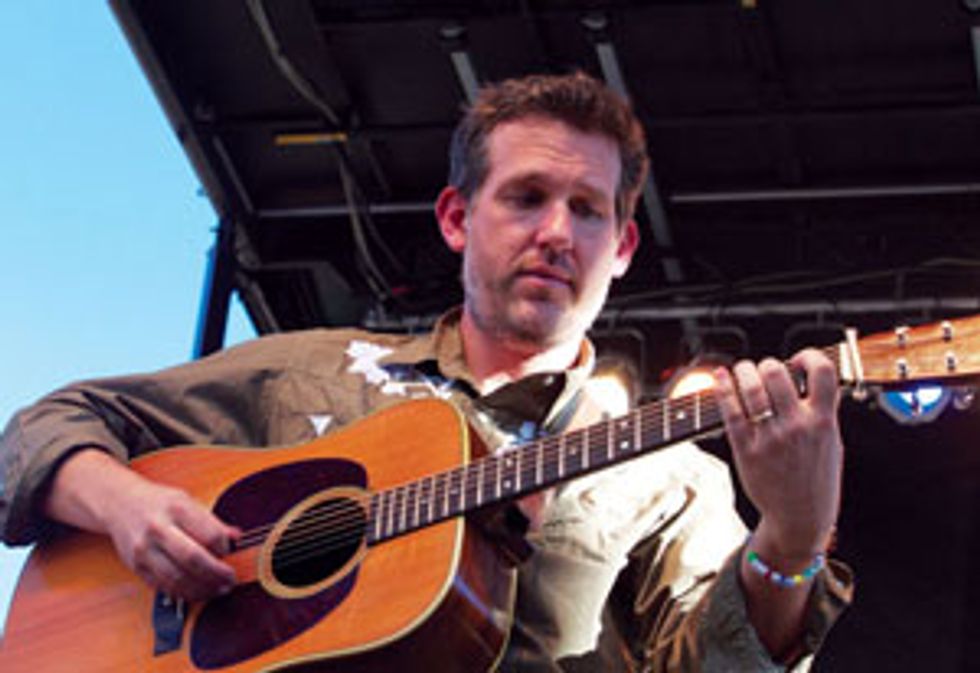
Where does composition come into the picture for you? Is it hard to make time for that?
It’s easy for me to get bogged down in the mass of everything that’s going on between sessions, as a player or producer, tours, or the teaching that I’m doing. I’ve learned to set some time aside or be aware of when it’s like, “Okay, there’s a good energy right now and I’ve got this idea.” Basically, just offering more time to that.
Sometimes, even on planes, I’ll have ideas for lyrics and I’ll just try to sit there and imagine it while I’m in a seat for two hours. Or, if I’m home with a guitar, just knowing that I have a couple hours here to myself. Just use those moments. It’s about finding little open times where I feel I can push something along. On my iPad I’ve got a constant churn of notes—unfinished things. I like knowing there’s always something on the workbench.
With so many different projects at any one time, how do you fit in live shows?
When I’m out playing, there are things I’m associated with where my name is a little more part of the draw. It’s less of a gig where I just happen to be there. I’ve tried to steer towards things that offer me an opportunity to play some of my original music. The Hot Rize band is a unique blend where it’s a band under a singular name, but I’m not really a sideman in that, I’m one of the four. The collective artistry of that band has a good energy.
When I do dates with Noam Pikelny, it’s equal billing, essentially. The other thing I’m doing is a trio with David Holt and T. Michael Coleman. It’s more or less a Doc Watson tribute with that kind of music and spirit. But again, it’s more like a band or collective.
As far as session work goes, it continues to separate itself as just what I do when I’m in Nashville. A lot of the records I’m playing on you probably wouldn’t be able to tell if it was me or not. I guess that’s why I love to play live dates where it really matters, at least to me, that it’s me up there playing. I’m putting real specific, artistic energy into something where I don’t necessarily do that as a Nashville session player working on some Top 40 country song.
On this album you cover everything from solo guitar to a bluegrass quintet. Which format do you feel most comfortable in?
That’s a good question. I’m thinking about that because I’m trying to figure out what to do when I go out to play shows under my own name. Tim O’Brien has always been a great career model for me because he can make any of that work. I’m such a scattered kind of guy with this and I really love the variety, but if I had to peg it, I think a solid four-piece with bass, mandolin, fiddle, and me would be really fun. There are things with a trio that are just second to none but there’s this power with a larger ensemble. All I can do is try to make a record that covers all that. If I had to put a band together to tour for this record specifically, it would probably be in the line of a bluegrass setup.
When you think of that larger bluegrass sound, what names come to mind?
I’ve always been drawn to the sound of Béla Fleck and Tony Rice or Sam Bush and Jerry Douglas. Those guys playing together create such a huge wall of greatness, you know. When I’m onstage and feeling that five- or six-piece bluegrass sound, it’s about as close as a guy like me would get to a big rock show. It’s that kind of power. It’s a little harder to bring that kind of bigness and energy to a trio.
Bryan Sutton’s 10 Essential Bluegrass Albums
The Essential Bill Monroe & His Blue Grass Boys – Columbia Country Classics
You see the whole evolution of bluegrass through this compilation. It’s hard for me to decide the one Bill Monroe album that’s the best, but this gives you a really good sense of how the bluegrass sound developed. Plus, you get some really good recordings of that initial five-piece band with Monroe, Earl Scruggs, Lester Flatt, Chubby Wise, and Cedric Rainwater. Those were the guys who created the exact template for what a bluegrass band should sound like. You always have to start there.
Flatt and Scruggs – The Complete Mercury Recordings
This collection probably represents three or four albums from their “golden” era. This band was more influential around my area than in other places, for whatever reason. I guess since Earl was from North Carolina there was a little more connection with all the banjo players I was around growing up. Flatt and Scruggs reigned supreme around Western North Carolina when I was a kid.
Stanley Brothers – The Complete Columbia Stanley Brothers
I learned more about the Stanley Brothers as I got older and started playing gigs outside of my hometown. The Stanley Brothers had this whole soul thing in there, and it’s a huge part of what bluegrass is with that emotion and personal connection. Carter Stanley had such a way to draw you in as a singer and listen to his stories. This collection represents their prime era with those songs and Carter’s soul.
John Hartford – Aereo-Plain
I’m really fascinated how guys can turn the page yet still keep older music very much relevant and alive. It’s this balance of tradition and innovation that’s really intriguing. This is a record that will always be on my iPods from here forward. John Hartford had a wonderful sense of originality and great modern songwriting when he was in his prime, along with his great banjo and fiddle playing.
Doc Watson – Southbound
I just have to involve Doc. This is my favorite record of his and it’s really not some of the flashiest picking in the world, but you feel like you’re sitting in the room with him. There are some classic Doc Watson fiddle tunes on there, but there’s just a vibe about this record that feels so warm. Literally every time I hear that record I’m there in that room with him. It was an essential honesty that Doc Watson had. Outside of his humor, songs, and flashy picking, you had this very rooted sense of self. That record sums a lot of it up for me.
J.D. Crowe & The New South
Most bluegrass fans just call it “0044” because that was the Rounder catalog number. That’s the first real collection of J.D., Ricky Skaggs, Tony Rice, and Jerry Douglas working together. That was a band that played a lot over a few years in Kentucky, but really only existed to make this one record. This is the modern classic bluegrass record. That sound ushered in the modern bluegrass era for most bands that came after.
The Tony Rice Unit – Manzanita
This is the ultimate Tony Rice album for me because of his tone, ability to creatively interpret a song, and his supreme originality. Anytime I want to hear what acoustic guitars should sound like, I put that record on.
Skaggs & Rice
It’s what I’m always drawn to. This album has an adherence to these older sounds with a modern energy that just makes it more accessible.
The Bluegrass Album Band, Vol. 1
They did four other records, but this first one made a large splash in the bluegrass scene as a kind of a reassessment of older material done with modern hands. For me, and for most people who are around my age, those collections were seminal, important records.
Béla Fleck – Drive
This was the first time I had heard that massive sound with Tony Rice, Béla, Sam Bush, and Mark Schatz working together. This is the real thing here with incredibly deep musicianship. I’m really drawn to Béla’s ability as an instrumentalist and songwriter. He understands how to be technically proficient and musical at the same time.
Bryan Sutton and banjoist Noam Pikelny perform at Carter Vintage during an album release party for Into My Own. Photo by Bill Filipiak
You have Sam Bush on several tracks on the new album. What did his music mean to you growing up?
He has always been a hero of mine and more recently, a friend. He is certainly one of the great bluegrass musicians of all time and he sort of defined what could be considered “Act II.” You get this whole new wave in the mid ’70s with Ricky Skaggs, Tony Rice, Sam, and Jerry Douglas. For me, growing up when I did, Sam’s name was just as relevant to bluegrass as Bill Monroe. Just like Tony Rice was as relevant as Doc Watson.
The album opens with “Cricket on the Hearth,” an old bluegrass standard. Do you remember when you first heard that tune?
I remember that my sister, who plays fiddle, used to play it. I’d never recorded it and I’m such a fan of a really good fiddle tune. It has melodic interest and it’s a good vehicle for the flatpick.
With a fiddle tune like that, which may have been recording dozens of times, how to do approach the arrangement and keep it sounding fresh?
It depends on the spirit of the record, and it’s usually a production call. We would see how it fits in with other things around it because they are essentially open-ended with variations on a theme. With “Cricket on the Hearth,” it was really one of the only go-get-’em fiddle tunes on the album. If I had another song of that same ilk on the record, I would have done something different. I always try to maintain a production mindset of keeping things balanced, where you don’t have too much of one thing or not enough of something else.
“Cumberland Reel” was inspired by guys like Béla and Sam and their playing from Strength in Numbers up through Tales From the Acoustic Planet. Those albums heavily influenced how I view my original bluegrass and acoustic material.
“That’s Where I Belong” comes out of the British school of country music. What was your first exposure to that scene?
In high school I got that first Notting Hillbillies record, and it was always one of my favorites. I like their interpretation of things and I like the spirit of that whole record. I’ve always been drawn to Mark Knopfler and how he integrates traditional sounds with his modern, more rock thing. I looked into some other stuff by Brendon Croker, the guy who wrote that piece, and he’s got a pile of great songs. I wouldn’t consider myself a connoisseur of the British country music scene, but through the filter of Mark Knopfler, I’ve been exposed to some pretty good music and writers.
Sometimes when you hear country—and especially bluegrass—filtered through the players that come out of Australia, Canada, or Europe certainly, you get a really strong sense of the work they’ve done when it comes to studying. Mark Knopfler studied Chet Atkins and it’s great to hear how that has informed what he does. These folks have really spent a lot of time on it, almost more than the folks in this country have spent on the craft of that style.
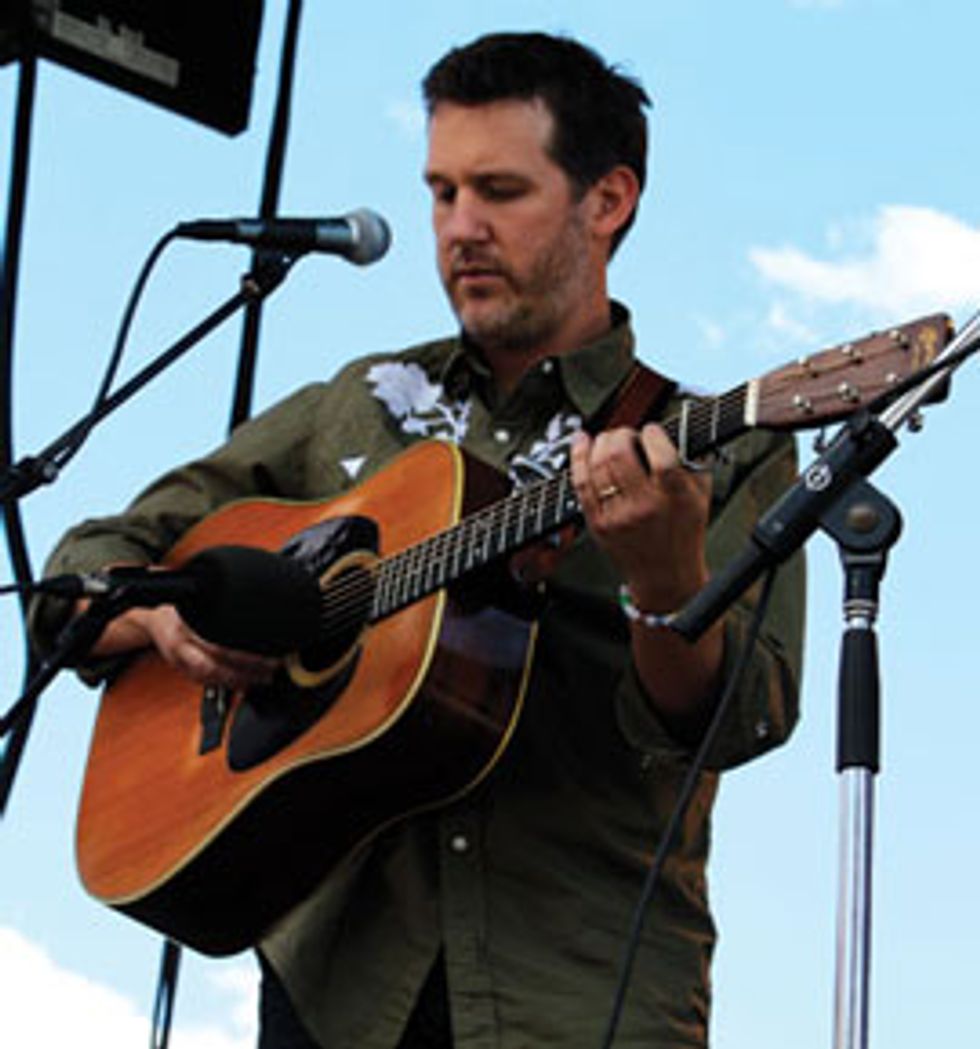
Tell us the story about the double-pickguard Martin on the cover of the new album.
It has been my main guitar for the last few years. It’s a 1948 D-28. The second pickguard was put on sometime in the ’70s. By the time I had bought it they had already converted it back to a right-handed guitar, but the lefty guard was still on there. The neck really feels correct to me. I’ve got other herringbones that probably sound better than this guitar, but there’s something about it that just feels right to my hands. It feels real subconscious when I play, and I like that [laughs]. So that’s the one I mainly used on the record.
For the tune with Frisell I played a 1934 Martin 0-18, and the last tune on the record, “Been All Around This World,” was a 1942 Martin 0-17 my grandfather bought new in San Francisco when he was in the Navy.
It sounds like you keep your setup pretty simple.
I try to be as simple and have as few moving parts as possible when it comes to acoustic guitar. I’m a big believer in having the right guitar and the right mic. Obviously, in the studio, I’m sensitive to what the preamp is doing. My favorite setup in general is a pair of Neumann KM 54s through an API-style preamp. Sometimes I’ll veer off for specific sounds with ribbon mics, but as a rule, that setup is the best starting block for me.
Bryan Sutton's Gear
Guitars
1948 Martin D-28
1934 Martin 0-18
1942 Martin 0-17
1943 Martin D-28
Strings, Picks, and Accessories
D'Addario EJ17 Phosphor Bronze strings (.013-.056), Blue Chip and Wegen Bluegrass picks, McKinney-Elliott Capos
Most everything on this album was cut as a band. The Frisell track with Dennis Crouch was cut altogether in a room with no headphones at Buddy Miller’s studio, which is basically just a big room—the console is right there in the room. The other songs were cut as a band at Brent Truitt’s studio in East Nashville.
Speaking of the Frisell track, how did that collaboration come together?
I first heard Bill play when I first moved to Nashville. He made a record here [Nashville] with Jerry Douglas, Adam Steffey, and Ron Block. It introduced me to him, and I was really intrigued not by his prowess on the guitar, but his general approach and how he interpreted music. There’s some very wide-brush artistry going on with him, especially coming from my alternating, up-and-down, flatpicking fiddle tune background. To hear the space and these long notes, I’ve always been drawn to that as a contrast to a lot of the sounds that are in me naturally.
I wrote this tune upon hearing him for the first time. Just the way those flat thirds rub up against the major thirds was inspired by his sound. Low and behold, that song has just lived in my head for a majority of the last 15 years or so. About two years ago I did a series of shows in Denver at a jazz club called Dazzle. My friend Greg Garrison, who plays on the record, was hosting this series called Improvised Roots. He would bring in one of his pals from the bluegrass world and pair them up with a known jazz player. I did three nights with Bill and really got to know him better. During this run we got to play this tune. As it came along, I knew he was going to be in Nashville working on a record with Buddy Miller later that year, so I just kept it in the back of my mind. We found a day when he was off and he was already set up in the studio there, so it was a really casual, convenient type of thing. Plus, he already knew the tune, so it was really fun to document that experience and play it with him again. I am really pleased and honored to have him on there.
“Watson’s Blues” is an obvious tribute. With the trio you have with David Holt and T. Michael Coleman, do you feel like you are pushing Doc’s legacy forward?
I think part of the lineage of bluegrass players and this type of music is that nobody is really trying to replace anyone because we all have too much respect. But what you try to do is move things forward in a way that feels correct for you and also feels correct in the sense of making that tradition obvious in your music. I want to be original and I want to be my own sound, and I don’t want to spend the rest of my life rehashing the rest of what Doc’s done, or Tony. But I want someone to know who listens to me that yeah, Doc has influenced me and so has Tony, Dan Crary, and Norman Blake. I like to think that the sound of all these people I love and really respect shows up in my playing. The more I can pay attention to my original summation of all of those things, either through my own writing or by interpreting other people’s compositions, the more different parts of those guys will come out. That’s really all I can hope for.


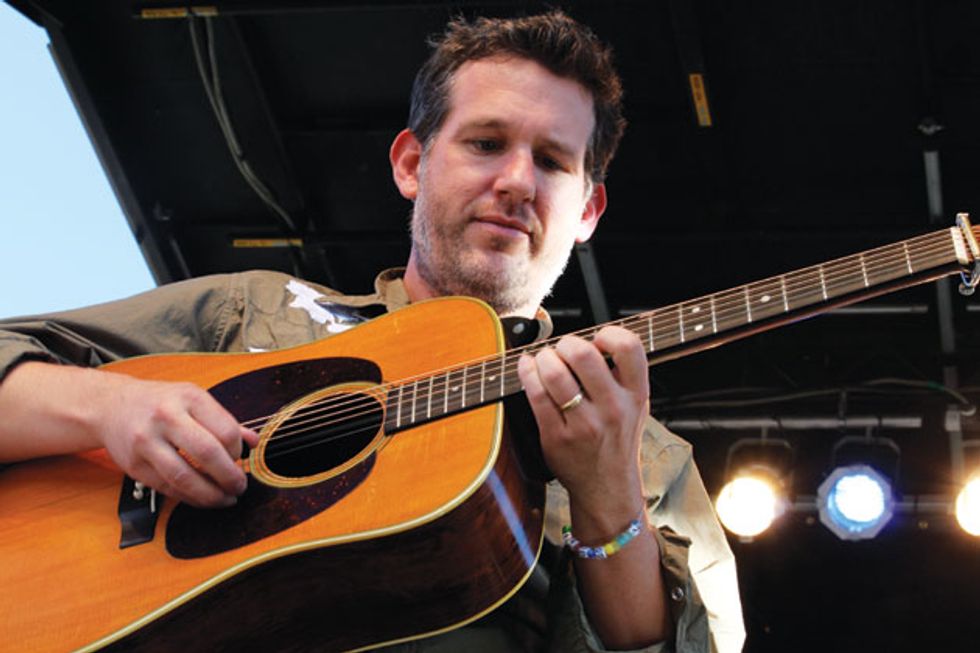

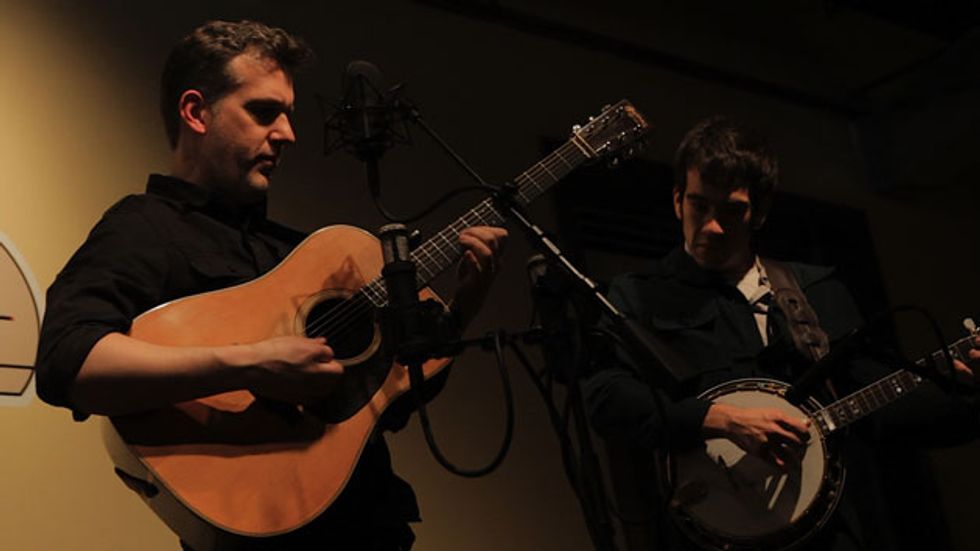
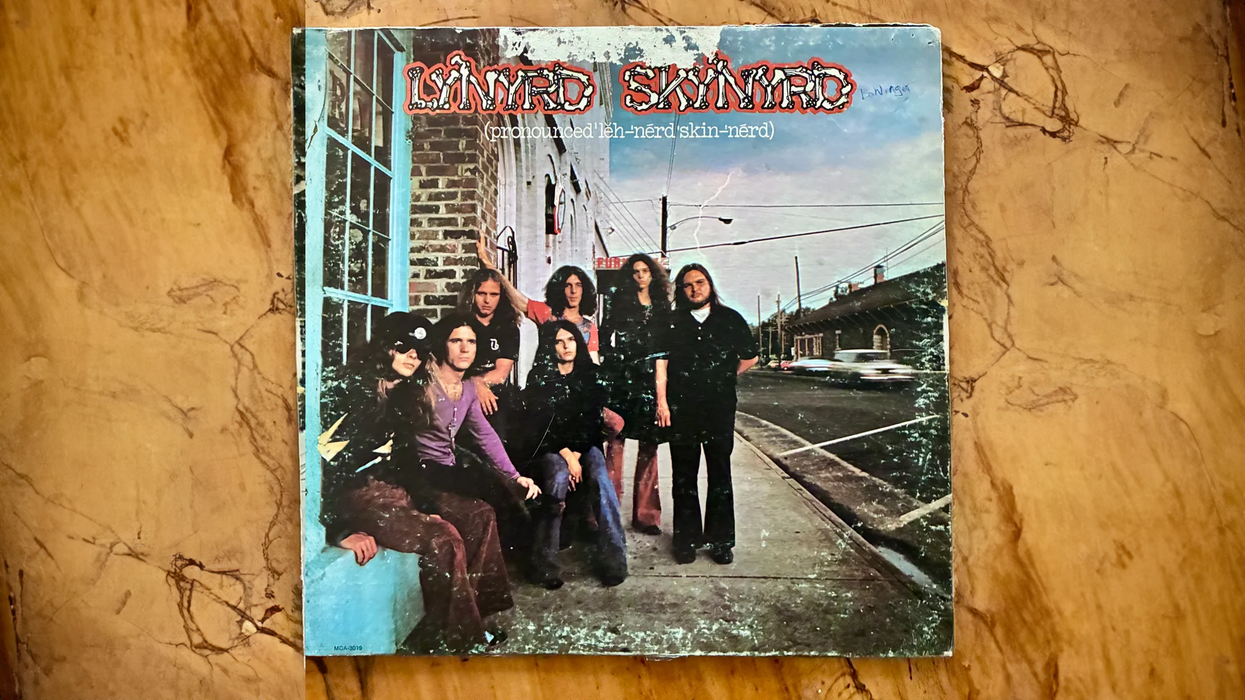

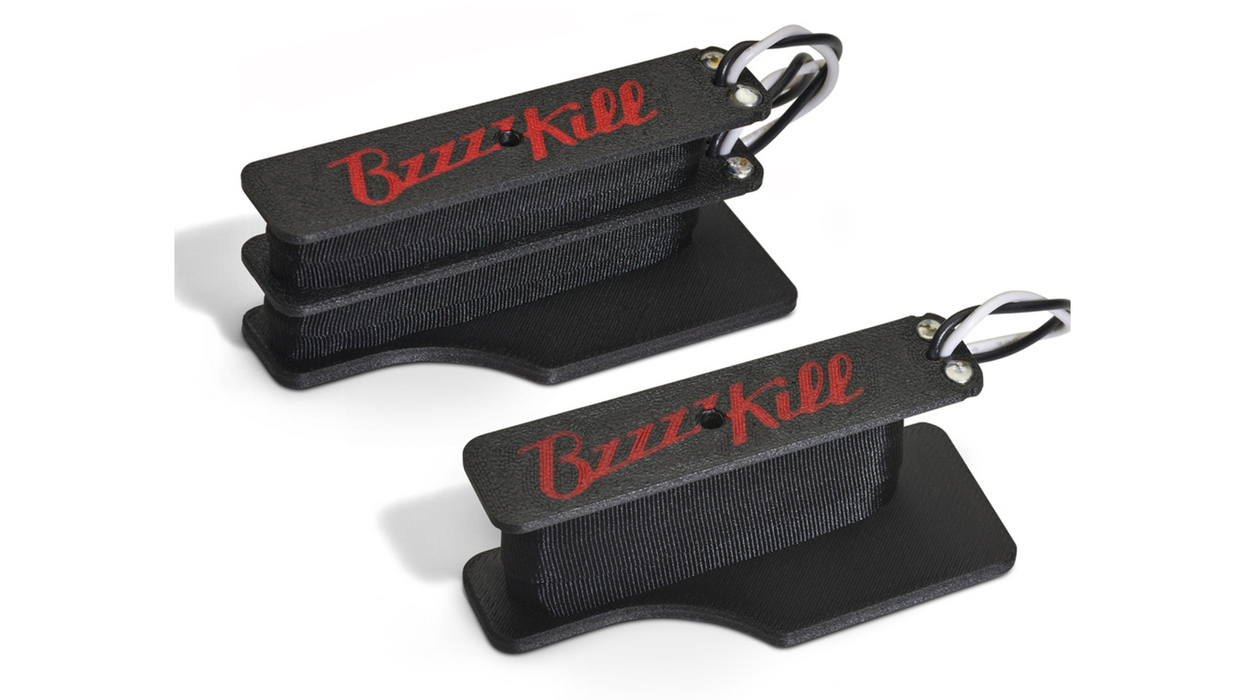
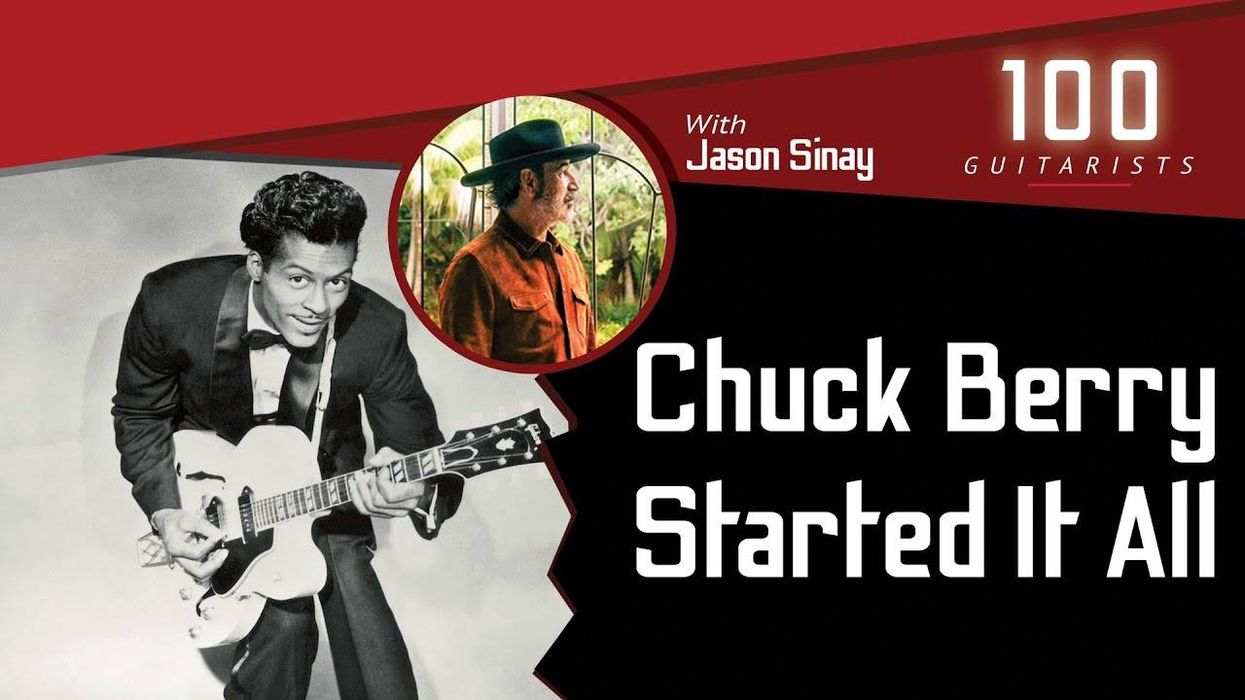




![Rig Rundown: Russian Circles’ Mike Sullivan [2025]](https://www.premierguitar.com/media-library/youtube.jpg?id=62303631&width=1245&height=700&quality=70&coordinates=0%2C0%2C0%2C0)
















